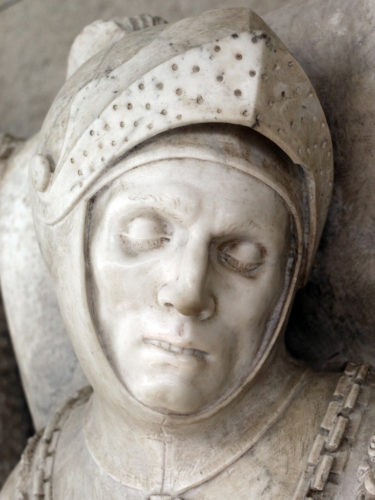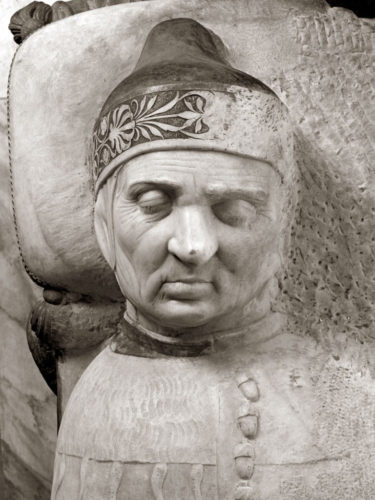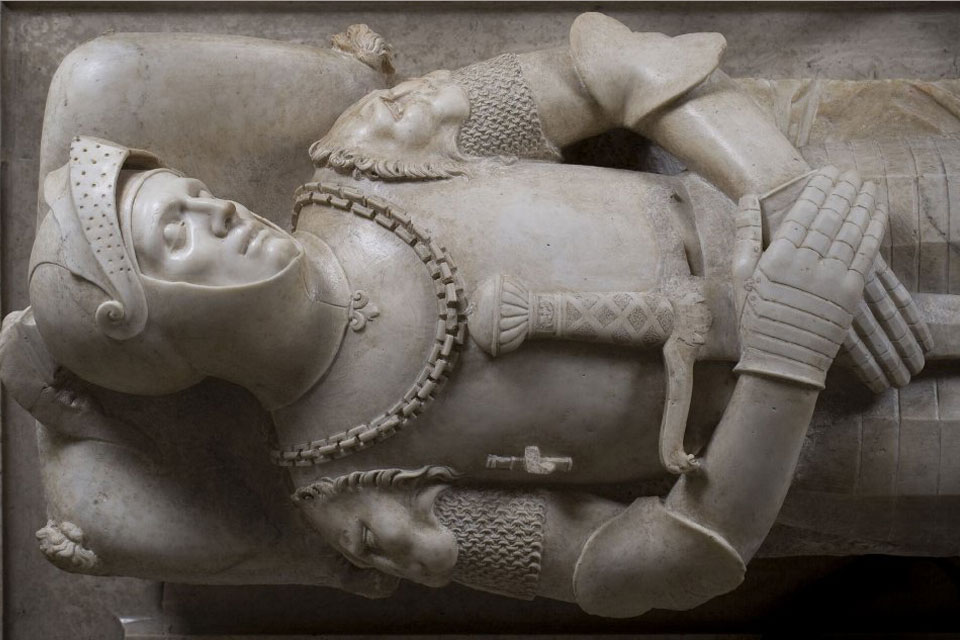Guidarello Guidarelli (* Ravenna, c. 1450, † Imola, 06.03.1501) was an Italian military leader in the service of Cesare Borgia. He is famous for his effigy. Normally on show at the Pinacoteca di Ravenna, it is currently on display at the Scuderie del Quirinale in Rome in connection with an exhibition commemorating the 200 year anniversary of the return of art looted by Napoleon.
Guidarello Guidarelli was born sometime between 1450 and 1460 in Ravenna, which at this time was under the rule of the Venetian Republic. He stemmed from a Florentine family, which had moved into the city of Romagna in the early fifteenth century.
His father, who was a notary had seven children of whom Guidarello Guidarelli was the eldest. Man-at-arms, Guidarello was knighted by the Emperor of the Holy Roman Emperor Frederick III in 1468. In September of 1498 he fought as commander of the Venetian army in a war between Florence and Pisa (supported by Venice) at a battle at Lake Bientina. He also took part in the siege of Marradi in 1498. At the beginning of 1499 he was hired as a mercenary by Pope Alexander VI. Nevertheless, in August he was back again in the pay of Venice, fighting in Croatia against the Ottoman Turks, finally returning to the pay of the Pope in December. At this time, Guidarello was married to Benedetta Del Sale, belonging to the noble family of Del Sale.
From now on until his death three years later, he took part in the military campaigns that would bring Cesare Borgia to conquer Romagna. During this period he held the rank of CaptainImola was the first city to fall in 1499 with the family of Sforza first to be expelled Signoria. Later came Forli and, after a brief pause, Cesena, Rimini and Pesaro at the border between the Marche and Romagna. During the entire period Guidarello served as an informant for the Republic of Venice. Finally he took part in the siege and attacks on the city of Faenza in the winter 1500 – 1501.
Death


While waiting to launch the decisive attack of Faenza, Cesare Borgia and his entourage were enjoying the carnival organising tournaments, bullfights and masked balls. It was during a great masked ball held at Imola in the last days of February that Guidarello Guidarelli was mortally wounded.
As of today, no certain information is avalable as to the circumstances and the reasons behind the murder. According to one hypothesis Guidarelli was killed out by henchemen of Cesare Borgia, caused by his role as double agent. However, in 1930 a cronicle was discovered according to which he was the victim of a trivial dispute over a golden embroidered cloak, which Guaderelli had lent to a certain Vigilio; as he would not return it, it ended in a brawl followed by a duel. Heavily wounded, Guidarelli was carried to the house of the jurist Penserio Sassatelli. Here he managed to dicate his will and in connection with this, organise his funeral. His remains were to be buried in the church of San Francesco in Ravenna. As part of his testament he ordered for 600 ducats to be set aside for sculptural works on his tomb. Nevetheless, it took more than 25 years for this wish to be carried out. In 1827 the descendents had his tomb removed to the new Accademia di Belle Arti in Ravenna, where it is now exhibited in the former monastery of Santa Maria in Porto.
Featuring a glamorous young knight, one of the mysteries surrounding the exquisite tombstone was the artist responsible for the art. During the 19th century Giacomello Baldini, Severus of Ravenna, Peter Lombardo or his sons, Antonio or Tullio Lombardo were all floated, until the discovery of a reciept for a pyament to Tullio Lombardo for his work in the St. Liberius chapel was discovered.
However, art historians have questioned whether the present sculpture work is in fact the original renaissance tomb. While spurs, shoes and gloves are traditionally stylized, some hold that the face of the knight looks much more like a romantic reconstruction carried out in the beginning of the 19th century.
Nevertheless, the latest monograph by Anne Markham Schultz does not question the attribution. Notably, she writes how “Tullio chose to portray the condottiere at the age of approximately 33 – the age at which Christ died and thus the age at which the dead will rise again – despite the fact that the captain was close to fifty, if not a good deal older. Indeed, the Effigy of Guidarello is unequalled among Italian Renaissance effigies for the beauty of its youthful and idealized visage” [1].
It is highly probable the artist had a death-mask to work with, but nevertheless chose to depict a chivalric ideal, rather than presenting a portrait of Guidarello. But it is also possible that Tullio only worked on the face, while his workshop was responsible for the rest of the effigy. Some claim that the sculptured face of the Guidarello is said to be of a quite different order than the other sculptural work carried out by Tullio Lombardo. However, it seems as if a cusory comparison of the effigy of the Doge on the vendramin tomb with that of the Guidarello must lay this objection to rest.
The myth
Whatever the date of the sculpture, the death mask of Guidarello came to inspire numerous poets in the 19th century writing about the evocative and dreamlike qualities of the face of the knight. Out of this grew a popular myth, that unmarried girls who kiss Guidarello will be married within a year; women, already married would be blessed with a son, just as beatiful as the young knight. In the 20s and 30s this led to yet another boom of interest in the sculture among female tourists, who travelled far to smear it with lipstick. Finally, when it was recovered after WW2 from its hiding place, curators decided to place it in depot ion the basement in order to preserve it from this inordinate practice.
Nevertheless, it was recovered from the basement in 1970 and re-xhibited. At some point a special office was erected to handle letters from all over the world sending money to pay for red roses to be placed at the tomb.
Restoration
In 2004 the latest restoration took place cleaning the staue for the residue of lipstick, plaster, mortar and dirt, which had accumulated through the centuries. There is now a total ban of touching the sculpture, which is guarded by cameras.
Exhibition in Rome 2017
The effigy of Guidarello Guidarelli is currently on display in Rome at the Scuderie del Quirinale until March 13th 2017, highlighting the return of the Italian art in 1816, which had been looted by Napoleon. Other works on show are by Caracci, Guercino, Reni,and Vecellio.
SOURCE:
 Guidarello Guidarelli : interventi conservativi, nuovi studi e ricerche
Guidarello Guidarelli : interventi conservativi, nuovi studi e ricerche
By Nadia Ceroni, Alberta Fabbri and Claudio Spadoni
MAR – Museo d’Arte della Città di Ravenna 2009
EAN: 9788890531873
The Sculpture of Tullio Lombardo
By Anne Markham Schulz
Harvey Miller Publishers for VISTAS, 2014
ISBN 9781909400177
VISIT:
Il Museo universale. Dal sogno di Napoleone a Canova
Scuderie del Quirinale, Rome
16.12.2016 – 12.03.2017
FEATURED PHOTO:
Guidarello Guidarelli. Press Photo: Scuderie del Quirinale 2016
